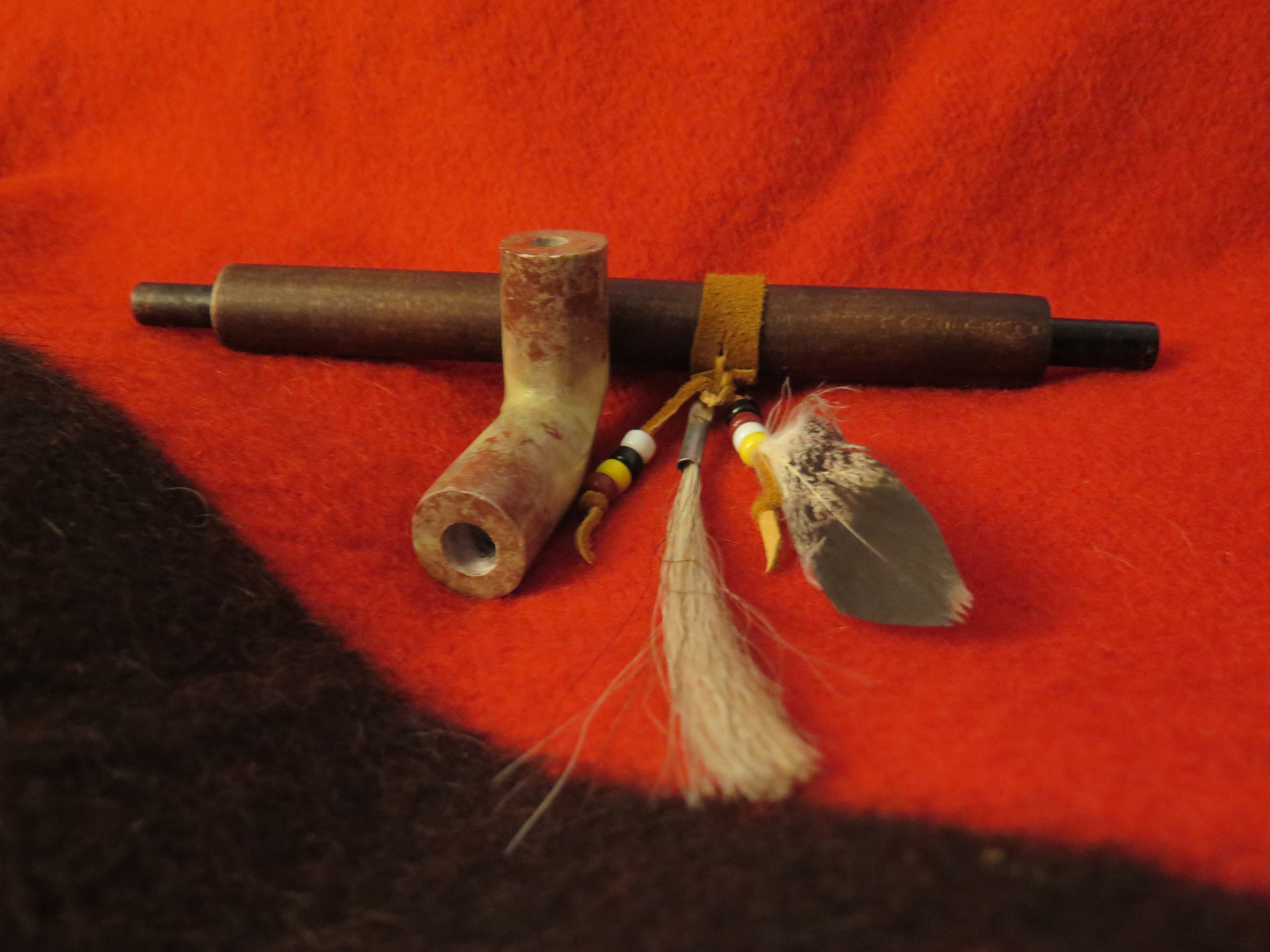
Native American Ceremonial Pipes: Sacred Vessels of Prayer, Diplomacy, and Community
Native American ceremonial pipes, often erroneously simplified as "peace pipes," are profound spiritual artifacts central to the cultural, religious, and social life of numerous Indigenous nations across North America. Far from being mere smoking devices, these pipes are sacred vessels, intricately designed and imbued with immense spiritual power, serving as conduits for prayer, platforms for diplomacy, instruments for healing, and symbols of community and identity. Understanding their significance requires a deep appreciation for the worldviews that shaped their creation and use, recognizing them as living objects within dynamic spiritual traditions.
Nomenclature and Etymology
While the term "peace pipe" is a common, albeit reductive, descriptor in English, it is a colonial simplification that fails to capture the multifaceted roles of these sacred objects. The term "calumet," derived from the Norman French word chalemel (meaning reed or pipe), was adopted by early European traders and missionaries in the Mississippi Valley to refer to the long-stemmed pipes used by various Algonquian and Siouan-speaking peoples. While "calumet" is widely recognized, Indigenous nations possess their own specific names. For instance, among the Lakota, the sacred pipe is known as Chanunpa, a term that carries deep spiritual resonance, referring not just to the physical object but to the entire ceremonial complex surrounding it. Other nations have their own distinct terms, reflecting the diversity of their languages and traditions.
Anatomy and Craftsmanship: A Synthesis of Earth and Spirit

A ceremonial pipe typically consists of two main parts: the bowl and the stem. The materials chosen for each component are not arbitrary but are imbued with symbolic meaning, often representing aspects of the natural world and the spiritual universe.
The Bowl:
The bowl, which holds the sacred tobacco or other plant mixtures, is predominantly carved from stone. The most revered stone for pipe bowls, particularly among Plains tribes, is catlinite, a soft, reddish-pink argillite found primarily in the pipestone quarries of Pipestone National Monument in southwestern Minnesota. This stone is considered sacred, believed to be the solidified blood of the ancestors or the flesh of the Earth Mother. Its red color symbolizes the blood of the people, their sacrifices, and their connection to the land. Other stones, such as steatite (soapstone), chlorite, or various local hardstones, were also used depending on regional availability and cultural preference. The shape of the bowl varies greatly, from simple inverted cones or L-shapes to more elaborate effigy pipes depicting animals, human figures, or spiritual beings, each carrying specific symbolic weight relevant to the nation’s cosmology.
The Stem:
The stem, typically made from wood, serves as the conduit connecting the human breath to the sacred fire in the bowl. Ash, sumac, cedar, and other woods were commonly used, often carefully hollowed out. The length of the stem can vary significantly, from short, hand-held pipes to elaborate, meter-long ceremonial stems. Stems are frequently adorned with intricate carvings, quillwork, beadwork, feathers, animal fur, human hair, and paint, each decoration carrying specific meaning related to the individual, family, clan, or nation. Feathers, for example, might represent connection to the sky world or specific spirit guides, while beadwork patterns could tell stories or symbolize spiritual protection. The act of joining the bowl and the stem is itself a sacred ritual, symbolizing the union of male (stem, sky) and female (bowl, earth), or the coming together of different elements of creation to form a unified whole.
The Sacred Plant: Tobacco and Other Offerings
At the heart of the ceremonial pipe’s use is the sacred offering of tobacco. Unlike the commercially processed tobacco used recreationally, traditional Native American tobacco (Nicotiana rustica or other native varieties) is often more potent and is cultivated and prepared specifically for ceremonial purposes. It is regarded not as a stimulant, but as a sacred plant, a direct gift from the Creator. When burned in the pipe, its smoke is believed to carry prayers and intentions directly to the spirit world, the Creator, and the ancestors.
In addition to tobacco, various other indigenous plants, such as red willow bark (kinnikinnick), bearberry, sage, sweetgrass, and cedar, might be mixed with the tobacco or used on their own. These plants are chosen for their medicinal properties, aromatic qualities, and spiritual associations, each contributing to the purification, healing, or specific intent of the ceremony. The act of loading the pipe is therefore a conscious and reverent preparation of an offering to the sacred.
Profound Spiritual and Communal Significance

The significance of ceremonial pipes extends across a multitude of interconnected spheres:
-
Prayer and Communication with the Sacred: This is perhaps the primary function. The pipe is a direct line to the divine. The rising smoke is understood as a visible manifestation of prayers and intentions ascending to the Creator, the Ancestors, and the Spirit World. It acts as an intercessory agent, carrying human thoughts and requests directly to the divine, seeking guidance, blessings, healing, or offering gratitude. Smoking the pipe transforms the individual’s breath into a sacred offering, uniting the physical and spiritual realms.
-
Peacemaking and Diplomacy: The most widely known, yet often misunderstood, role of the pipe is in peacemaking. The "peace pipe" is not merely a symbol of an end to conflict but a sacred instrument used to forge and solemnize agreements, treaties, and alliances between individuals, families, clans, and nations. When individuals smoke from the same pipe, they are not just sharing tobacco; they are entering into a sacred covenant, binding themselves by the spiritual power of the pipe and the presence of the Creator. To break such an agreement was to offend the Creator and invite severe spiritual consequences. This act elevates negotiations beyond mere human words, imbuing them with spiritual weight and commitment.
-
Healing and Purification: Pipes are frequently used in healing ceremonies to restore balance and well-being. The smoke is believed to cleanse and purify individuals, spaces, and objects, driving away negative influences and inviting positive spiritual energies. Shamans, medicine people, and spiritual leaders use the pipe to diagnose illness, offer prayers for recovery, and facilitate spiritual healing processes, connecting the patient to the healing powers of the cosmos.
-
Rites of Passage and Social Cohesion: The pipe marks significant life events and reinforces social bonds. It is present at births, naming ceremonies, coming-of-age rituals, marriages, and funerals, sanctifying these transitions and acknowledging the individual’s place within the community and the spiritual cycle of life. Sharing the pipe fosters a deep sense of community, solidarity, and mutual respect among participants, reaffirming their shared identity and values.
-
Symbol of Authority and Lineage: In many cultures, the pipe is a symbol of leadership, wisdom, and responsibility. Chiefs, elders, and spiritual leaders often possess pipes that have been passed down through generations, embodying the history, knowledge, and spiritual power of their lineage and nation. The pipe grants the bearer authority within a ceremonial context and signifies their role as a guardian of tradition and a bridge between the physical and spiritual worlds.
The Ritual Act: A Journey of Intent
The use of a ceremonial pipe is a highly ritualized and deliberate act, never performed casually. The specific protocols vary widely among nations, but common elements include:
- Purification: Before handling the pipe, participants may cleanse themselves through smudging (burning sacred herbs like sage or sweetgrass) or other purification rituals.
- Preparation: The pipe bowl is carefully filled with sacred tobacco or other mixtures, often with specific prayers or intentions accompanying each pinch.
- Offerings to the Directions: Before lighting, the pipe is typically offered to the four cardinal directions (East, South, West, North), representing aspects of creation, elements, or spirit beings; to the Sky (Creator, Grandfather); and to the Earth (Mother Earth, Grandmother), acknowledging the interconnectedness of all things.
- Lighting and Inhalation: The pipe is lit, and the smoke is inhaled and exhaled with profound reverence, carrying the prayers upward.
- Passing the Pipe: The pipe is often passed in a specific direction (e.g., clockwise) among participants, each taking a few puffs and offering their own prayers or intentions. This act symbolizes unity and shared purpose.
- Completion: Once the ceremony concludes, the pipe is carefully disassembled, cleaned, and stored in a sacred bundle, awaiting its next use.
Diversity Across Nations
It is crucial to emphasize that while the core spiritual significance of ceremonial pipes is widespread, the specific forms, materials, rituals, and meanings vary considerably among the hundreds of distinct Native American nations. A pipe used by a Lakota individual on the Plains will differ in appearance and ceremonial context from one used by a Haudenosaunee (Iroquois) person in the Woodlands or a Pueblo elder in the Southwest. Each tradition has its own sacred stories, protocols, and interpretations, reflecting the unique cultural and ecological landscapes from which they emerged.
Historical Context and Modern Relevance
During the colonial era, European observers often misunderstood or deliberately misrepresented the ceremonial pipe, reducing it to a quaint curiosity or a simple "peace pipe." This trivialization contributed to the broader erosion of Indigenous cultures and the suppression of their spiritual practices. Despite these challenges, many Native American nations preserved their pipe traditions, often in secret, ensuring their survival through generations.
Today, ceremonial pipes continue to be vital to the cultural revitalization and spiritual well-being of Indigenous communities across North America. They are used in traditional ceremonies, intertribal gatherings, and personal prayer, serving as powerful symbols of resilience, identity, and the enduring connection to ancestral ways. The practice of pipe making and pipe ceremony continues to be taught and learned, ensuring that these sacred vessels remain active and living conduits between the people, the land, and the spirit world.
In conclusion, Native American ceremonial pipes are far more than historical artifacts or simple smoking instruments. They are sacrosanct objects, meticulously crafted and deeply embedded in the spiritual, social, and political fabric of Indigenous nations. As vessels for prayer, instruments of diplomacy, tools for healing, and symbols of community, they embody a profound worldview that honors the interconnectedness of all creation. Respectful understanding of their true significance is essential for appreciating the richness and depth of Native American cultures and their enduring spiritual legacies.


